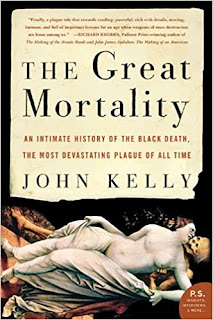The Great Mortality
In the category Disease for the 2021 NONFICTION READER CHALLENGE, I read The Great Mortality: An intimate history of the Black Death, the most devastating plague of all time by John Kelly, 2006.
It
was particularly interesting to read about a pandemic during the Covid-19
pandemic. The plague is now often referred to as the Black Death, but it was known
to Europeans at that time as The Great Mortality, which Kelly calls “the
greatest natural disaster in human history.” In the introduction, he mentions
writing about a patient who had AIDS in the early 1990s [in a previous book], when there were no effective treatments, and writes,
“A hallmark of a pandemic disease is its ability to destroy worlds, not just
individuals, but it was one thing to know that, quite another to witness it.”
And, he adds what was at that time “newly emerging illnesses such as Ebola
fever, Marburg disease, Hantavirus pulmonary syndrome, SARS, and avian flu.”
So, adding the Covid-19 virus brings this up to date.
He
describes in excruciating detail how devastating the plague was – not only in
its first outbreak, but also in subsequent outbreaks for the next three
centuries. “The sheer scope of the medieval plague was extraordinary. In a
handful of decades in the early and mid-fourteenth century, the plague
bacillus, Yersina pestis, swallowed Eurasia
the way a snake swallows a rabbit – whole, virtually in a single sitting. From China
in the east to Greenland in the west, from Siberia in the north to India in the
south, the plague blighted lives everywhere, including in the ancient societies
of the Middle East: Syria, Egypt, Iran, and Iraq.”
Kelly’s
research is from current historians and microbiologists, and from letters,
chronicles, and reminiscences of contemporaries who experienced the plague. I
found it particularly interesting that Kelly writes about the plague as if it
were a living entity (“Then in August, after death had done all that death
could do, Y. pestis bade farewell to
the Balkans and moved northward into Hungary, Austria, and Germany.” And his
use of verbs: “Crossing the Grand Pont to the Ile de la Cité, the pestilences visited
the Hôtel-Dieu…,” “then
travelled to … and like a good guest it left …”).
At
first I found the structure of the chapters rather confusing; Kelly often moves
back and forth in time within a chapter. But then I realized that each chapter
focuses on a different country or area of Europe and Asia. In describing how
the plague advanced through the area and the specific effects it had, Kelly
includes background information to put it into perspective. He also makes
comparisons between different places and, where the experience of the plague was
different, he explains why. So in addition to information about the pandemic
and the disease itself, there is a lot of historical input.
The
final chapter is about what he calls the ‘Plague Deniers;’ not because there
are scientists and historians who deny there was a plague, but that they
believe the disease was not caused by the plague bacillus. He presents evidence
that negates these views and states, “However, about one thing we can be
certain. Microbiologist Didier Raoult is right; the Black Death was an outbreak
of plague.” However, there still seem to be some puzzling aspects of the
disease and its progression that Kelly also presents.
There
is so much detail in this book – about the disease itself, how it spread, what effects
it had, the innovations that resulted from it – that it is difficult to cover
it all in a book review. But for anyone interested in the consequences of a
pandemic, in the Black Death itself, in history, or in the impact of events on
society, this book is highly recommended.


Comments
Post a Comment